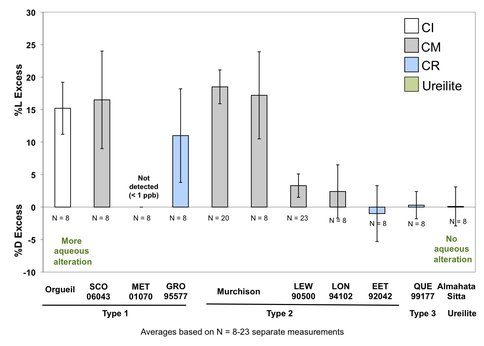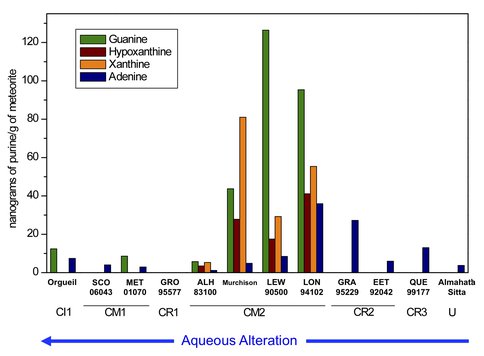2010 Annual Science Report
 NASA Goddard Space Flight Center
Reporting | SEP 2009 – AUG 2010
NASA Goddard Space Flight Center
Reporting | SEP 2009 – AUG 2010
Research Activities in the Astrobiology Analytical Laboratory
Project Summary
We are a laboratory dedicated to the study of organic compounds derived from Stardust and future sample return missions, meteorites, lab simulations of Mars, interstellar, proto-planetary, and cometary ices and grains, and instrument development. Like forensic crime shows, the Astrobiology Analytical Laboratory employs commercial analytical instruments. However, ours are configured and optimized for small organics of astrobiological interest instead of blood, clothing, etc.
Project Progress
A little over 4.5 billion years ago, our solar system was a disk of gas and dust, newly collapsed from a molecular cloud, surrounding a young and growing protostar. Today most of the gas and dust is in the spectacularly diverse planets and satellites of our solar system, and in the Sun. How did the present state of the planetary system come to be from such undistinguished beginnings? The telling of that story is an exercise in forensic science. The “crime” occurred a long time ago and the “evidence” has been tampered with, as most planets and satellites display a rich variety of geological evolution over solar system history.
Fortunately, not all material has been heavily processed. Comets and asteroids represent largely unprocessed material remnant from the early solar system and they a represented on Earth by meteorites and interplanetary dust particles. Furthermore, telescopic studies of the birthplaces of other solar systems allow researchers to simulate those environments in the laboratory so that we may characterize the organic material produced.
We are a laboratory dedicated to the study of organic compounds derived from Stardust and future sample return missions, meteorites, lab simulations of Mars, interstellar, proto-planetary, and cometary ices and grains, and instrument development. Like forensic crime shows, the Astrobiology Analytical Laboratory employs commercial analytical instruments. However, ours are configured and optimized for small organics of astrobiological interest instead of blood, clothing, etc. This role allows us to work with other themes within GCA and other NAI teams. To further the study of authentic samples, extraterrestrial samples, and their analogs, this year we have achieved the following:
- We have relocated our laboratory from Building 2 to Building 34 at GSFC. This provided us with a custom designed lab space of 1800 ft2, approximately triple the area of our previous space. While disruptive, the move was efficient and will have long-term benefits for this research effort (Figure 1).
- Dr. Michael Callahan, an NPP for the last two years was hired as a GSFC civil servant on August 30, 2010. This illustrates the importance GSFC places on Astrobiology and the work of this laboratory.
- Analysis of the 13C/12C ratio of the glycine extracted from Stardust foils demonstrates that the carbon in glycine found on these foils is extraterrestrial. The results are published in Meteoritics and Planetary Science. This result was listed as the number 8 story of 2009 by Astrobiology Magazine: http://www.astrobio.net/index.php?option=com_retrospection&task=detail&id=3345
- Also using compound specific isotopic analysis, we were able to measure the 13C and 15N enrichment in various amino acids in fungal peptides in collaboration with Hans Brueckner, Giessen University, Germany. We have additionally characterized the amino acids in these via LCMS. We have shown that the isotopic ratio correlations as well as the chemical diversity and chirality are effective tools in distinguishing extraterrestrial from biological contamination. This work is currently in review in Astrobiology.
- We have expanded our search for amino acid enantiomeric excesses to include the more aqueously altered CM1 and CR1 meteorites (Figure 2). This work provides additional evidence that amplification of left handed amino acid enantiomeric excesses occurred on the meteorite parent body during an extended aqueous alteration phase. A manuscript is currently in press in Meteoritics and Planetary Science.
- We have collaborated with ARC to detect uracil produced from the photolysis of pyrimidine-containing ices, the manuscript is in press in Astrobiology.
- With CIW we studied the amino acids in extracts from some of Stanley Miller’s original spark discharge experiments containing sulfur.
- We hosted one graduate student for 4 months (Karen Whelley, Penn State) who examined nucleobases in spark-discharge experiments as part of her dissertation.
- We have performed the first amino acid analysis of the meteorite Almahata Sitta, aka asteroid TC3 (Figure 2). A manuscript is currently in press in Meteoritics and Planetary Science.
- With CIW we studied the amino acid distribution and stable isotopes in three unusual and pristine samples of the Tagish Lake meteorite. Results were presented at the Meteoritical Society meeting.
- We have searched for biological and non-biological purines and pyrimidines in 12 meteorites (Figure 3). We have extracted and are ready to analyze the 15N isotopes of the nucleobases in the CM2 meteorite LON 94102.
Dworkin and Glavin have also been deeply involved in preparing a Phase A Proposal for the OSIRIS-REx New Frontiers-3 mission. This carbonaceous asteroid sample return mission addresses three points of the Astrobiology Roadmap:
(2) Determine any chemical precursors of life in the solar system.
(3) Characterize the cosmic sources of matter for potentially habitable environments in the solar system.
(6) Understand the principles that will shape the future of life, both on Earth and beyond.
Glavin was awarded the Nier Prize by the Meteoritical Society for outstanding early career science.
Figure 1. Figure 1. The 1800 square foot laboratory is custom designed for the NAI supported research performed here (left). The laboratory is operational and used by the project investigators (from top to bottom, Glavin, Dworkin, Callahan, Elsila, Stern) (right).
Figure 2. Figure. 2. The enantiomeric excess of L-isovaline with various carbonaceous metorites arranged in approximate order of mineralogical aqueous alteration. There is an apparent a correlation between the magnitude of L-isovaline excess and aqueous history. There also is an apparent inverse correlation between abundance and L-isovaline excess.
Figure 3. Figure. 3. The distribution of nucleobases with various carbonaceous metorites arranged in approximate order of mineralogical aqueous alteration. The CM2 meteorites appear to be in a particularly efficient region with respect to the aqueous history of the meteorite, and possibly the ammonia and formaldehyde abundances in the parent body.
Peer Reviewed Publications:
Elsila J.E., Callahan M.P., Glavin, D.P. Dworkin, J.P., Bruckner, H. (submitted) “Distribution and stable isotopic composition of amino acids from fungal peptaibiotics: Assessing the potential for meteoritic contamination,” Astrobiology
Glavin, D.P., Callahan, M. P., Dworkin, J. P., Elsila, J.E. (2010) The effects of parent body processes on amino acids in carbonaceous chondrites. Met. Planet. Sci. in press.
Glavin, D.P., Aubrey, A., Callahan, M.P., Dworkin, J.P., Elsila, J.E., Parker, E., Bada, J.L., Jenniskens, P., and Shaddad, M. H. (2010) Extraterrestrial amino acids in the Almahata Sitta meteorite. Met. Planet. Sci. in press.
Glavin, D.P., Dworkin, J.P., Lupisella, M., Williams, D.R., Kminek, G., and Rummel, J.D. (2010) In Situ Biological Contamination studies of the Moon: Implications for Planetary Protection and Life Detection Missions. Earth, Moon, and Planets, in press.
Sandford, S.A., Bajt, S., Clemett, S.J., Cody, G.D., Cooper, G., DeGregorio, B.T., De Vera, V., Dworkin, J.P., Elsila, J.E., Flynn, G.J., Glavin, D.P., Lanzirotti, A., Limero, T., Martin,, M.P., Snead, C.J., Spencer, M.K., Stephan, T., Westphal, A., Wirick, S., Zare, R.N., and Zolensky, M.E. (2010) Assessment and control of organic and other contaminants associated with the Stardust sample return from comet 81P⁄Wild 2. Met. Planet. Sci. 45, 406-433.
Meierhenrich, U.J., Filippi, J-J., Meinert, C., Vierling, P., and Dworkin, J.P. (2010) On the Origin of Primitive Cells: From Nutrient Intake to Elongation of Encapsulated Nucleotides. Angew. Chem. Int. Ed. 49, 3738–3750.
Elsila J. E., Glavin D. P., and Dworkin J. P. (2009) Cometary glycine detected in samples returned by Stardust. Met. Planet. Sci 44, 1323-1330.
Nuevo, M., Milam, S.N., Sandford, S.A., Elsila, J.E., and Dworkin, J.P. (2009) Formation of Uracil from the Ultraviolet Photo-Irradiation of Pyrimidine in Pure H2O Ices. Astrobiology 9, 683-695.
Conference Presentations and Invited Seminars:
Callahan, M.P., Glavin, D.P., Elsila, J.E., Dworkin, J.P., Aubrey, A., Parker, E.T., and Bada, J. L. (2009) “ Amino Acid Analyses of the Almahata Sitta Meteorite.” Division of Planetary Science. (Contributed talk)
Dworkin, J.P. and Glavin, D.P. (2009) “Excess left handed amino acids in meteorites” Seminar, Lebanon Valley College. (Invited talk)
Dworkin, J.P., Glavin, D.P., Callahan, M.P., and Elsila, J.E. (2010) “L-Amino acid enrichments in carbonaceous meteorites: Implication for the origin of biological homochirality.” Astrobiology Science Conference, Abstract #5004, League City, TX, April 26-29. (Contributed talk)
Elsila, J.E. (2010) “Searching for amino acids in meteorites and comets” Gordon Research Conference on Organic Geochemistry. (Invited talk)
Elsila J.E., Callahan M.P., Glavin, D.P. Dworkin, J.P., Bruckner, H. (2010) Annual Meeting of the Meteoritical Society, poster entitled “Fungal peptaibiotics: Assessing Potential Meteoritic Contamination” (Contributed poster)
Elsila, J.E., Glavin, D.P. and Dworkin, J. P. (2010), “Cometary amines and amino acids from Stardust” Astrobiology Science Conference (Contributed talk)
Elsila, J.E., Glavin, D.P. and Dworkin, J. P. (2010) “Cometary amines and amino acids from Stardust” NASA Astrobiology Institute “Workshop Without Walls” (Contributed talk)
Elsila, J.E. (2009) “Cometary amino acids from the Stardust mission” Boston University Center for Space Physics Fall Seminar Series. (Invited talk)
Elsila, J.E., Glavin, D.P. and Dworkin, J. P. (2009) “Cometary amino acids from the Stardust mission” Space Telescope Science Institute; Planets, Life and the Universe: Astrobiology Lecture Series. (Invited talk)
Glavin, D.P., Callahan, M.P., Dworkin, J.P., Elsila, J.E., and Herd, C.D.K. (2010) Parent body influences on amino acids in the Tagish Lake meteorite. 73rd Annual Meteoritical Society Meeting, Abstract #5131, New York City, NY. (Contributed talk)
Glavin, D. P. (2010) Biological contamination studies of lunar landing sites. Royal Astronomical Society “Astrobiology on the Moon” Lecture, Burlington House, London, UK. (Invited talk)
Glavin, D.P., Callahan, M.P., Dworkin, J.P., and Elsila, J.E. (2010) “The effect of aqueous alteration on amino acids in meteorites.” NAI Virtual Workshop, Carnegie Institution of Washington, Washington DC. (Contributed talk)
Glavin, D.P., Callahan, M.P., Elsila, J.E., Dworkin, J.P., Aubrey, A., Parker, E.T., and Bada, J. L. (2010) “Extraterrestrial amino acids in the Almahata Sitta meteorite.” 41st Lunar and Planetary Science Conference, The Woodlands, TX. (Contributed talk)
Glavin, D.P., Callahan, M.P., Elsila, J.E., Dworkin, J.P., Aubrey, A., Parker, E.T., and Bada, J. L. (2009) “Extraterrestrial amino acids in the Almahata Sitta meteorite.” Workshop on Asteroid 2008 TC3, University of Khartoum, Sudan. (Contributed talk)
Glavin, D.P. and Dworkin, J. P. (2009) “Southpaw solar system? L-Amino acid excesses in meteorites and implications for the origin of life.” NAI Director’s Seminar. (Invited Talk)
Stern, J. C., Elsila, J. E., Callahan, M. P., Glavin, D. P., Martin, M. G., and Dworkin, J. P. (2009) “Above detection limits – Prebiotic organics in comets and carbonaceous meteorites.” American Geophysical Union, Fall Meeting. (Contributed talk)
Publications
-
Elsila, J. E., Glavin, D. P., & Dworkin, J. P. (2009). Cometary glycine detected in samples returned by Stardust. Meteoritics & Planetary Science, 44(9), 1323–1330. doi:10.1111/j.1945-5100.2009.tb01224.x
-
Meierhenrich, U. J., Filippi, J-J., Meinert, C., Vierling, P., & Dworkin, J. P. (2010). On the Origin of Primitive Cells: From Nutrient Intake to Elongation of Encapsulated Nucleotides. Angewandte Chemie International Edition, 49(22), 3738–3750. doi:10.1002/anie.200905465
-
Nuevo, M., Milam, S. N., Sandford, S. A., Elsila, J. E., & Dworkin, J. P. (2009). Formation of Uracil from the Ultraviolet Photo-Irradiation of Pyrimidine in Pure H 2 O Ices. Astrobiology, 9(7), 683–695. doi:10.1089/ast.2008.0324
-
Sandford, S. A., Bajt, S., Clemett, S. J., Cody, G. D., Cooper, G., Degregorio, B. T., … Zolensky, M. E. (2010). Assessment and control of organic and other contaminants associated with the Stardust sample return from comet 81P/Wild 2. Meteoritics & Planetary Science, 45(3), 406–433. doi:10.1111/j.1945-5100.2010.01031.x
-
PROJECT INVESTIGATORS:
-
PROJECT MEMBERS:
Michael Callahan
Collaborator
-
RELATED OBJECTIVES:
Objective 2.1
Mars exploration.
Objective 3.1
Sources of prebiotic materials and catalysts
Objective 3.2
Origins and evolution of functional biomolecules
Objective 7.1
Biosignatures to be sought in Solar System materials






